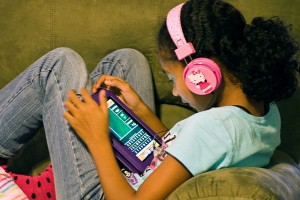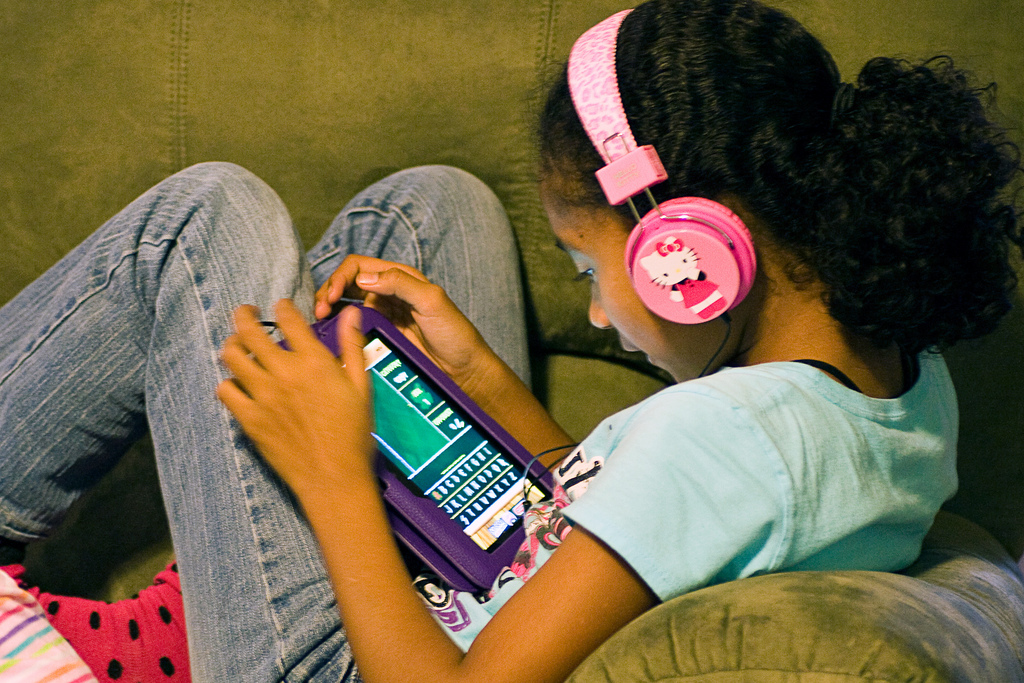By Zoe Allen, for The Children’s Book Review
Published: September 27, 2013

With the proliferation of mobile technology for learning, physical books are slowly becoming obsolete. A 2012 Pew Research Center study revealed that the “e-book-reading population is on the rise in the United States, growing up to 23 percent of all Americans, 16 and older.” Although, the e-book is here to stay, printed books still have readership value. In this article, we will be discussing the advantages and disadvantages of a Kindle and a physical book.
The Kindle: Portable Education
Pros
- It is lighter
The Kindle Paperwhite‘s dimensions are 6.7 x 4.6 x 0.36 inches, and it only weighs 206 grams. This device carries all the resources your kids need, in a single platform. The screen is perfect for a child’s hand, and it fits well on anyone’s palm. It’s also light enough to be carried anywhere with you.
- Multitasking
Without physical pages to turn or leaf through, your child’s hands are free to multi-task. They could catch up on the latest Dr. Seuss story, while downloading another educational application. Also, students can now maximize their time by researching and doing their work online.
- Bounty of Online Resources
Since these devices can connect to the Internet, children can use it to browse through the available resources online.
- Cheaper Content
The production and distribution of e-books tend to be cheaper, compared to their printed counterparts. Once publishers release new titles, readers can easily purchase and download them on their devices.
Cons
- Lack of a Tactile Feel
There is no substitute for the feeling of holding a page between your fingers, and delicately turning it to see the next page. Although, the Kindle uses a page-turning animation to mimic this action, it still lacks that tactile feel.
- Battery-reliant
Since it’s an electronic device, the Kindle is dependent on its battery to operate. Once the battery is depleted, the user has to charge it. To enjoying reading your favorite e-book, you must keep it charged at all times.
The Physical Book: Tactile Tradition
Pros
- A Tactile User Experience
For printed books, it’s all about familiarity and tradition. Although, you can take notes and highlight text electronically on your device, there’s just something about the organized chaos brought about by Post-Its and highlighter pens. They give us a more tactile user experience.
- Eco-friendliness
Possibly, the biggest advantage of a printed book over an e-book is that; it doesn’t rely on batteries to run. All you need is a well-lighted place and you’re set to read right away. Paper is also made from recyclable material, which is more environmentally friendly than a Kindle’s plastic and metal components.
- Sentimental and Monetary Value
When books become obsolete, its market value actually increases. Collectors prefer classic printed books, to an old piece of electronic device. These books also have sentimental value, since you can touch them, compared to downloaded electronic applications.
Cons
- Handling
Depending on the type of book, some may be too cumbersome for a child to manage on their own. Other books may be too delicate for a child because of age.
- Price and Rarity
The new releases, as well as the rare ones, written by famous authors can be sold for a premium price. Others may be out of print or unavailable in your area, and these books may require extra costs for shipping.
The Verdict
The decision lies in your personal needs and means at the moment. If you feel that your child would benefit more from the portability of a Kindle, then by all means, it’s a good buy. Likewise, if you feel that a printed book’s ease outweighs the pros of an e-book, you don’t need to spend money on one. If you own both, which do you prefer and why? Tell us in the comment section below.
About the Author: Zoe Allen is always interested in new technology, fashion, indie music and online media. In her spare time she can always find for travel and she also maintains a passion for modern art.

